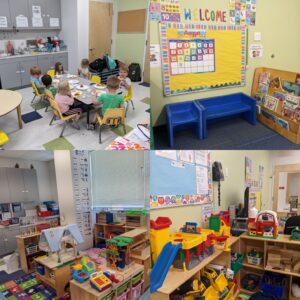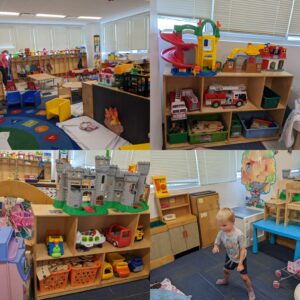In all of our classrooms, educational goals are individualized to each student based on their needs. Our program is designed to maximize every student’s potential in all areas of development. Our classrooms are taught collaboratively with The Children’s School and Arlington Public School teachers and assistants present in the classroom. Particular attention and focus is given to communication, adaptive skills and social-emotional engagement as these areas are the biggest predictors of success in future schooling and in life beyond school.










PEEPS (Toddlers)
The Peeps and Toucans classes are smaller, integrated classes of 2-year-old toddlers. APS toddler students with special needs eat, play, and grow with their typically developing peers. The students work on goals and learn during free play and structured activities such as circle time, music, art class, and PE. The classroom teams include a special education teacher and a special education assistants.

CARDINALS/OWLS (Toddlers)
The Cardinals and Owls classes are integrated classes of 2s and young 3 year-olds. APS toddler students with special needs have the opportunity to learn, play, eat, socialize, and engage in a classroom with their peers without special needs. The classroom is co-taught by a general education teacher, general education instructional assistant and a special education instructional assistant, and a special education teacher that supports both classrooms each day.

Owl Classroom

Cardinals classroom
FINCHES/SWANS (3-4yrs)
The Finches and the Swans classes are integrated classes of 3-year-olds preparing to turn 4. APS pre-k students with special needs learn, play, eat, socialize, and engage with their peers without special needs during the school day. The classroom is co-taught by a general education teacher, general education instructional assistant and either a special education teacher or special education instructional assistant each day.
CRANES/FLAMINGOS (4-5yrs/pre-k)
The Flamingo and Cranes classes are integrated class of 4-year-olds preparing to turn 5 and getting ready for Kindergarten. APS Pre-K students with special needs learn, play, eat, socialize, and engage along side their peers. These classrooms are also co-taught by a general education teacher, general education instructional assistant and either a special education teacher or special education instructional assistant each day.
LORIKEETS (3-5yrs)
The Lorikeets classroom is a multi-age partnership classroom with The Children’s School. The classroom is comprised of children ranging in ages from 3-5 years. APS and The Children’s School staff work together to plan and teach developmentally appropriate skills for building friendships, becoming more effective communicators, engaging in creative thinking, and most importantly, becoming independent problem solvers. Utilizing a combination of APS literacy and math curricula, along with developmentally appropriate play and thematic curricula, the Lorikeets’ learn about the world and their individual roles in it. We celebrate our differences and share in individual triumphs. Each Lorikeet is treasured for their individuality and for how their personality adds to the life of our classroom.
Mini-MIPA
ROBINS (3-5yrs)
The Robins class is a Mini-MIPA (Multi-Intervention Program for Students with Autism) classroom. MIPA classrooms are reduced-ratio, special-education classrooms designed to provide more intensive supports to students with autism. Each student’s goals are individualized to his or her needs, however common areas of focus include functional communication, self-advocacy, adaptive skills, and foundational attention and social-emotional skills. The program uses a variety of strategies within a highly structured setting with the goal of preparing students to transition to less restrictive settings. We implement direct instruction (systematic, comprehensive, and structured instruction to implement educational goals and objectives). We use a total communication approach to instruction to provide our students with a multitude of communication modalities to improve receptive, expressive, and pragmatic language skills. In addition to communication we also address sensory motor needs of each student (vestibular, proprioceptive, tactile, auditory, visual, and movement).

 Contact
Contact  Calendars
Calendars Careers
Careers Engage
Engage  District
District